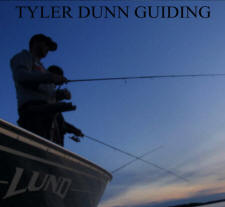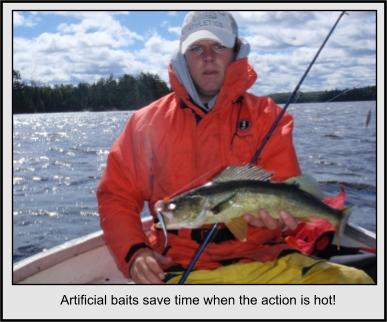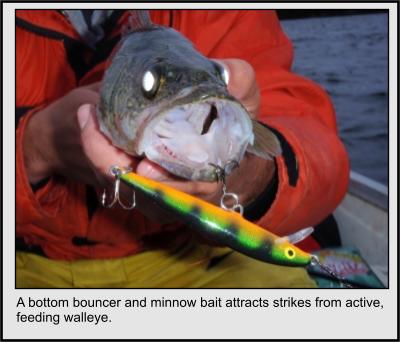|
 Bouncing
Bottom for Walleyes Bouncing
Bottom for Walleyes
By: Tyler Dunn
Tyler Dunn Guiding
A good bottom bouncing angler usually has it
down to an art and uses it as one of his best
search tools for walleyes during any month of
the open water season. They will know exactly
when more or less weight is needed and will
almost always be able to decipherer the
difference between a bite and a rock. Often this
is because of the rod used. A bait casting rod
in the 7-7 ˝ foot range with a soft tip or fast
action fits well for most situations. A soft tip
actually has a few benefits. I’ve found the
biggest advantage is you get a better feel of
the bottom bouncer making contact with structure
and more importantly the fish when it takes the
bait. With some practice and experience you will
soon be able to differentiate between a subtle
walleye bite and a few light ticks of a rock.
Another great asset for having a soft tip is
that walleyes have paper thin mouths. This has
made the walleye notoriously famous for being
lost due to hooks creating holes or even rips in
the fish’s mouth. Match the rod up with a good
bait casting reel such as a reel from Abu
Garcia’s line of Ambassador round reels. Low
profile reels will work just fine but try to
stay away from high gear ratio reels. These will
cause you to horse the fish which may result in
a hole in the walleyes mouth as I’ve mentioned.
A crawler harness is probably the most common
bait pulled behind a bottom bouncer. Speed is
one of the biggest factors when pulling a worm
on a harness. I like to stay in the 1.3-1.8 mph
area but often 1 mph or lower is needed. These
speeds are slow and just get the blades turning.
Often to get this slow, I drift with the wind
and kick the motor in and out of gear just to
keep boat control. I tie all my own crawler
harnesses on either 12 pound fluorocarbon and
even sometimes with monofilament. Always in
different lengths ranging from 24-48” with 36”
being my most commonly used lead length. When
walleyes are feeding furiously, time is money.
The window for the feedbag might only be for 45
minutes and the quicker you get back down into
the strike zone the better your chances are at
catching more fish. When your worm needs to be
replaced every minute or so, this becomes a
hassle. Simply switch to soft plastic baits like
Gulp. A gulp minnow nose hooked behind a harness
is a deadly offering when the bite is on. Very
little, if any rebating with these!

A minnow bait behind a bottom bouncer is an
unorthodox technique per say, but it does work
extremely well. An Original Rapala or any
shallow diving plug, 36” behind a bottom bouncer
tends to receive harder hits and often bigger
fish. This combination of a hard plug and bottom
excels on rocky structure. Don’t be fearful of
losing your $10 floating minnow baits because
more often than not the snag is just your bottom
bouncer stuck on a rock. When you feel your rod
load up on a snag, quickly let line out give
yourself some slack then quickly reel up. This
usually pops your rig out. If this doesn’t
release your rig, turn the boat around and drive
by not over the snag in the opposite direction
you were trolling when the snag happened. 9
times out of 10 this will work. Always tie your
leader line with a lighter pound test then your
main line with either a minnow bait or harness.
If your lure actually does become hung up on
something this will save you from breaking off
your bottom bouncer.

Bottom bouncing doesn’t come off as appealing as
jigging for walleyes does. What should be
appealing is the potential of these odd looking
V shaped wires with a sinker moulded on.
Although there is not a big learning curve it
does require time on the water practicing this
technique. A rule of thumb for new anglers using
bottom bouncers is to use 1 oz of weight for
every 10 feet of water you are fishing in. 1 oz
for 10 feet, 1.5 oz for 15 feet, 2 oz for 20
feet and so on. This will keep your line roughly
at a 45 degree angle. Once mastered, a new world
of walleye awaits you.
|